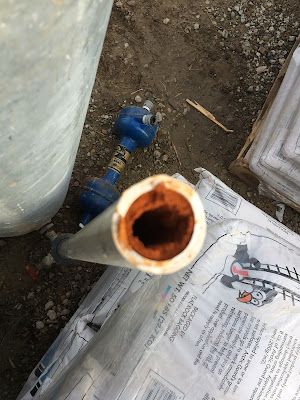Reverse Osmosis is a filtration method where water is forced
through a semi permeable membrane to reduce total dissolved solids and
contaminants to supply fresh drinking water.
A typical residential reverse osmosis system will have 3 to 5 stages of
filtration consisting of a 5 micron pre-filter or Carbon block filter, Reverse
Osmosis Membrane, Activated carbon post filter, In-line post carbon filter
and holding tank.
The pre-filter is
simply designed to remove sediment and some particulates before the membrane or
protect the membrane from chlorinated water supplies with a Carbon block pre-filter. The RO membrane is the primary stage of filtration and removes up to
99% of contaminants in the water.
Many
of these contaminants are VOC’s (Volatile Organic Chemicals) which the carbon
filtration stage is designed to reduce/remove and polish the water as a final
phase before delivery to the faucet or refrigerator.
The Reverse Osmosis Process:
The RO membrane consists of many layers of spiral wound
filaments which restrict the passage of contaminants and force them to the
drain. The product water is drawn from
the inside of the membrane and sent to a storage tank before it goes through
final carbon filtration as it goes to the RO faucet or refrigerator. A typical residential
Reverse Osmosis system can make anywhere from 10-75 gallons per day of high
quality water depending on the TDS (Total dissolved solids) of the incoming water supply, feed pressure
and temperature of the water. Generally the higher the TDS less product water and
lower quality water will be created. For high TDS water a “Booster Pump” is
used to boost the incoming water pressure to the membrane to improve quality
and quantity of water produced.
Cutaway of a Reverse Osmosis Membrane and RO Membrane in filter housing:
Particulate size removal chart for a Reverse Osmosis system:
Diagram of a Reverse Osmosis System installation under a sink:

When feasible it is recommended to have the reverse osmosis
system installed in the basement for easy maintenance, filter changes and to
not tie up valuable space under the sink.
Larger storage tanks can be used when installed in the basement and product
tanks can even be hung in the floor joists to help with water pressure to the RO
faucet and refrigerator. Delivery pumps
can also be used to boost the pressure from the storage tank to run water
across the basement, operate refrigerators efficiently and supply higher
pressure to multiple locations and RO faucets.
RO filters are changed every 6-12 months and the RO membrane is changed
every 3-7 years depending on water usage and incoming water quality to the
RO. Filters changes will run anywhere
from $60 up to $120 depending on the RO system. RO membranes generally cost $80
to $120. Anyone can change these filters
but there are certain procedures that need to be followed when changing RO
filters to protect against bacterial cross contamination from our hands that
can potentially contaminate the RO.
Periodic sanitizing of the complete RO system is recommended to prevent
possible contamination.
There are three styles of residential reverse osmosis
systems:
1. Basic RO system with 3-5 stages of filtration
2. 3-4 stage RO system with one piece manifold
3. 3-5 stage RO system with quick change filters
Reverse Osmosis storage tanks come in many sizes to accommodate necessary water storage:
Rather than getting into the histrionics about all the
dangerous things that can potentially be in our water and how they can be
hazardous to our health, let’s just address ONE fact. We all need to drink more water! Our Doctors tell us that, our bodies tell us
that every time we get thirsty and we all need to get away from drinking so
many sugary drinks, energy drinks, coffee, drinks with artificial sweeteners, etc.
Dehydration is actually the number one contributor to health related
issues. Our bodies are over 80% water so
keeping hydrated is of the utmost importance and drinking water is the only way
to rehydrate.
Having to constantly buy water, be it five gallon bottles or
cases of bottled water for drinking, is time consuming, expensive and a pain to
constantly be chasing water or scheduling delivery not to mention finding the
space to store it all. All of us need to
drink more water and many of us are, evidenced by the bottled water that is
flying off store shelves and being delivered weekly to households. The bottled
water industry has been growing by nearly 10% annually. Hey, we are paying $1.00
or more for a twelve ounce bottle of water! At that rate gasoline would be over $10 per
gallon! That is just ridiculous and on top of that bottled water is very
loosely regulated for quality and potability. A Reverse Osmosis drinking water system is the
answer to this problem. It's the most practical way of giving us all the quality water we need (AT PENNIES PER GALLON) and will give your family high quality drinking water
24/7, 365 days a year. So do yourself a favor! Go buy a Reverse Osmosis system for your family and DRINK UP there is plenty of water for everyone!
Here are some helpful links pertaining to reverse osmosis, drinking water contaminants, drinking water regulations and concerns about what may be in our water.
Wikipedia - What is Reverse Osmosis
EPA - Drinking water contaminants
EPA - Ground water and Drinking water
Wikipedia - Contaminant levels
How Stuff Works - Reverse Osmosis
Beauchamp Water Treatment and Supply
Good Water, Good Life!
Ray McConnell
Beauchamp Water Treatment and Supply
872 N Old US 23 Brighton, MI 48114
810-632-2000
www.beauchampwater.com
© All rights reserved. Beauchamp Water Treatment and Supply 2016
Raymond McConnell



























